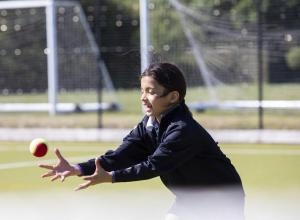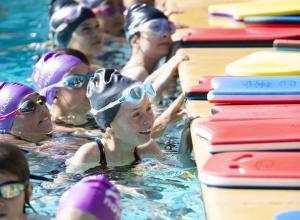
Setting boundaries for teenagers can be challenging and frustrating for parents but, argues Head of Harrodian Senior School, Andy Woodward, it's definitely worth the effort
Hello and welcome to my first post of the 2024-25 school year. In November (sorry). And it appears I am now taking requests! I fear the main request in this case (made by the clever colleague responsible for running and populating this fine website) was: ‘Any chance you could actually get on with it and write something new? Before I shut your page down!’ But, more specifically, they then asked if I fancied penning something on the topic of boundaries, and on their importance in life and parenting.
Well, I am very happy to oblige. Another wise person once told me, before I began my own journey as a dad, that parenting was above all about “love and boundaries”. They insisted that both should be unmistakable in the day-to-day life of a child, and that most parenting misfires come about when one or the other is neglected, ie discipline meted out without the balance of tangible affection, or life allowed to unfold as if it were one long Yes Day (a film with which my daughter is concerningly fixated!).
Another wise person once told me that parenting was above all about “love and boundaries”. They insisted that both should be unmistakable in the day-to-day life of a child, and that most parenting misfires come about when one or the other is neglected..
While life in the years since has inevitably thrown up parenting situations containing a little more nuance than that simple equation suggests, I still believe that the principle holds true. In truth, even the loving side of the equation isn’t as easy to fulfil as might be imagined – not because the underlying sentiment isn’t there, but because I’m usually tired, stressed and preoccupied before and after work, while young kids tend to be loud and cheerfully inconsiderate as a species. Therefore, the hugs, smiles and reassurances that make love ‘unmistakeable’ often take a conscious effort, rather than representing the default setting (but are certainly worth it).
But what of the boundaries? I think everyone can accept from the outset that these are fundamentally necessary. A world where anything goes is basically the plot of The Purge, and there’s a reason why that’s filed in the Horror section of Amazon Prime. However, we all know certain homes where that seems more like a fly-on-the-wall documentary. Let’s be frank – if aggression, or disrespect, or dishonesty, or sibling cruelty (and young children are certainly capable of all that and more) are allowed to occur without intervention or meaningful sanction, they can quickly become normalised and ‘just the way things are’. Too often it is then left to schools to pick up the pieces.
If boundaries are hard to find, ill-defined or excessively high and wide, then the testing of them can become an overly extreme sport.
But, as ever, I am writing here mostly with teenagers in mind, Senior School being my patch. Are we largely done with imposing such limitations by this stage? Has the time come to let them fly and see how they do? I fear you already know my answer… After all, this is in fact the more dangerous time, as decreed by evolution (development of the limbic system outpaces the prefrontal cortex in these years, impulse control taking a backseat as the young person pulls away from the parental nest in search of a necessary new independence). It is a season characterised by risk-taking and the testing of, yes, boundaries. So far, so natural. But if those boundaries are hard to find, ill-defined or excessively high and wide, then the testing of them can become an overly extreme sport. If, even by 14 or 15, notions of binge drinking, experimentation with drugs or unlimited screen time are normalised, then the child involved (and they are still a child) will have to go quite the extra mile to make their rebellion show, or to provoke a reaction.
Podcasting American paeditrican Dr Chris Magryta has written that ‘teenagers want rules secretly… They want to explore the world with some sense of safety where the parental guardrails are up to protect them from catastrophe.’ Perhaps more contentiously, a chapter in hit 2011 book ‘Nurture Shock’ by Bronson and Merryman even argued that very permissive parents often have ‘less well-adjusted children’ as teens may perceive the lack of rules as lack of care, also contending that ‘pushing a teen into rebellion by having too many rules was a sort of statistical myth’. This latter point is one we encounter regularly – the idea that overly restrictive boundaries force a child to rebel in dangerous secrecy. But, in truth, the knowledge that a young person has a curfew and the need to account for their behaviour once home tends to prove an inhibiting factor. It is also consistently scientifically proven that it’s worth fighting for a child to start drinking later. A report by the Institute for Alcohol Studies found that ‘the earlier a person drinks, the more likely they are to develop alcohol dependence or other alcohol-related problems in later life’ and that ‘each year a child delays drinking is associated with a 9–21% reduction in the chances of becoming dependent’, with risk ‘particularly acute below the age of 15’.
Hit 2011 book Nurture Shock argued that very permissive parents often have ‘less well-adjusted children’ as teens may perceive the lack of rules as lack of care
Less medically qualified than these authors I might be, but twenty years of working with young people have led me to absolutely believe that kids are happier, as well as safer, where parental boundaries are visible and known to all concerned. It also allows for genuine freedom within such agreed limits. At school, the most common pleas we receive are simply for consistency – for an application of the rules that all can agree on, expect and see delivered across school life. The game is rigged and frustrating if its rules appear and disappear, deemed important today but neglected tomorrow, applicable to one child and not to another. That’s a challenge for us – there being rather more teachers than parents in a teenager’s life, and each with their own priorities or powers of observation – but it is certainly good for anyone to know where they stand and, importantly, why. We should always be willing and able to explain the reasons for the boundaries that exist. The setting of them can even be a collaborative process, especially as our children get older. Usually, our base motive will be some version of ‘because we care for you and want you to be safe’. And, for all the eye-rolling that may result, that is ultimately hard to argue with or to begrudge.
The setting and applying of boundaries isn’t easy, but parenting was never meant to be that. I am convinced that it’s worth the effort involved. There will be plenty of time for our kids to find their own way once they have flown the nest as adults, leaning on the values we have taught them and the example we have set… but, thankfully, they remain our responsibility for a little while longer yet.

Andy Woodward, is Head of Senior School.
He welcomes feedback to this blog at website@harrodian.com







